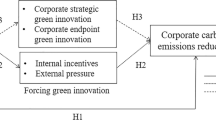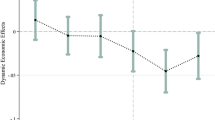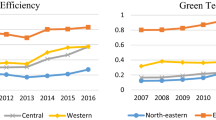Abstract
This study investigates the effect of China’s national Five-Year Plan for environmental protection (FYPEP) on corporate green innovations based on the two-way fixed effect model and panel data about the green patents of China’s publicly listed corporations during 1990–2020. Furthermore, the heterogeneity of these green innovations is further discussed with reference to the types of innovation, enterprise ownership, and the location of the corporations. It is found that FYPEP significantly induced corporation green innovations at regional and industrial levels. Heterogeneity analysis indicates that the inductive effect of FYPEP is stronger on green utility model patents than on green invention patents. State-owned enterprises react to green innovation policies more significantly than do private businesses. The inductive effect of FYPEP is stronger in Eastern China than in mid- and Western China. From the perspective of government intervention, this research renders a new framework for the formulation of policies of national environmental protection and corporate green innovation.


Similar content being viewed by others
Data availability
Original data of this manuscript comes from China National Intellectual Property Administration and CSMAR data center.
Notes
Data source: Ministry of Ecology and Environment of the People’s Republic of China, the website is https://www.mee.gov.cn.
References
Acs ZJ, Audretsch DB (2003) Innovation and technological change. In: Handbook of entrepreneurship research. Springer, pp 55–79
Ambec S, Barla P (2002) A theoretical foundation of the Porter hypothesis. Econ Lett 75:355–360
Anoulies L (2017) Heterogeneous firms and the environment: a cap-and-trade program. J Environ Econ Manag 84:84–101
Arimura T, Hibiki A, Johnstone N (2007) An empirical study of environmental R&D: what encourages facilities to be environmentally innovative. Environmental policy and corporate behaviour:142–173
Banerjee R, Gupta K (2019) The effect of environmentally sustainable practices on firm R&D: International evidence. Econ Model 78:262–274
Barbera AJ, McConnell VD (1990) The impact of environmental regulations on industry productivity: direct and indirect effects. J Environ Econ Manag 18:50–65
Brännlund R, Ghalwash T (2008) The income–pollution relationship and the role of income distribution: An analysis of Swedish household data. Resour and Energy Econ 30:369–387
Brunnermeier SB, Cohen MA (2003) Determinants of environmental innovation in US manufacturing industries. J Environ Econ Manag 45:278–293
Bu M, Qiao Z, Liu B (2020) Voluntary environmental regulation and firm innovation in China. Econ Model 89:10–18
Cai X, Zhu B, Zhang H, Li L, Xie M (2020) Can direct environmental regulation promote green technology innovation in heavily polluting industries? Evidence from Chinese listed companies. Sci of the Total Environ 746:140810
Carrión-Flores CE, Innes R (2010) Environmental innovation and environmental performance. J Environ Econ Manag 59:27–42
Cesaroni F, Arduini R (2001) Environmental technologies in the European chemical industry. Laboratory of Economics and Management (LEM), Sant’Anna School of Advanced Studies, Working Paper 9
Chen D, Li OZ, Xin F (2017) Five-year plans, China finance and their consequences. China J Account Res 10:189–230
Czarnitzki D, Kraft K (2004) An empirical test of the asymmetric models on innovative activity: who invests more into R&D, the incumbent or the challenger? J Econ Behav Organ 54:153–173
Dang J, Motohashi K (2015) Patent statistics: A good indicator for innovation in China? Patent subsidy program impacts on patent quality. China Econ Rev 35:137–155
Feng Y, Wang X, Du W, Wu H, Wang J (2019) Effects of environmental regulation and FDI on urban innovation in China: A spatial Durbin econometric analysis. J Clean Prod 235:210–224
Gray WB (1987) The cost of regulation: OSHA, EPA and the productivity slowdown. Am Econ Rev 77:998–1006
Guo Y, Xia X, Zhang S, Zhang D (2018) Environmental regulation, government R&D funding and green technology innovation: Evidence from China provincial data. Sustain 10:940
Hamamoto M (2006) Environmental regulation and the productivity of Japanese manufacturing industries. Resour and Energy Econ 28:299–312
Hille E, Althammer W, Diederich H (2020) Environmental regulation and innovation in renewable energy technologies: Does the policy instrument matter? Technol Forecast and Soc Chang 153:119921
Jaffe AB, Palmer K (1997) Environmental regulation and innovation: a panel data study. Rev Econ Stat 79:610–619
Jaffe AB, Peterson SR, Portney PR, Stavins RN (1995) Environmental regulation and the competitiveness of US manufacturing: what does the evidence tell us? J of Econ Lit 33:132–163
Jaffe AB, Newell RG, Stavins RN (2002) Environmental policy and technological change. Environ Resource Econ 22:41–70
Johnstone N, Haščič I, Popp D (2010) Renewable energy policies and technological innovation: evidence based on patent counts. Environ Resource Econ 45:133–155
Kesidou E, Wu L (2020) Stringency of environmental regulation and eco-innovation: Evidence from the eleventh Five-Year Plan and green patents. Econ Lett 190:109090
Krysiak FC (2011) Environmental regulation, technological diversity, and the dynamics of technological change. J Econ Dyn Control 35:528–544
Lanjouw JO, Mody A (1996) Innovation and the international diffusion of environmentally responsive technology. Res Policy 25:549–571
Lanoie P, Laurent-Lucchetti J, Johnstone N, Ambec S (2011) Environmental policy, innovation and performance: new insights on the Porter hypothesis. Journal of Economics & Management Strategy 20:803–842
Lee C-Y (2011) The differential effects of public R&D support on firm R&D: Theory and evidence from multi-country data. Technovation 31:256–269
Palmer MA, Ambrose RF, Poff NL (1997) Ecological theory and community restoration ecology. Restor Ecol 5:291–300
Peng X (2020) Strategic interaction of environmental regulation and green productivity growth in China: Green innovation or pollution refuge? Science of The Total Environment 732:139200
Popp D (2002) Induced innovation and energy prices. Am Econ Rev 92:160–180
Popp D (2006) International innovation and diffusion of air pollution control technologies: the effects of NOX and SO2 regulation in the US, Japan, and Germany. J Environ Econ Manag 51:46–71
Porter ME, Van der Linde C (1995) Toward a new conception of the environment-competitiveness relationship. Journal of Economic Perspectives 9:97–118
Price L et al (2011) Assessment of China’s energy-saving and emission-reduction accomplishments and opportunities during the 11th Five Year Plan. Energy Policy 39:2165–2178
Shadbegian RJ, Gray WB (2005) Pollution abatement expenditures and plant-level productivity: a production function approach. Ecol Econ 54:196–208
Shen C, Li S, Wang X, Liao Z (2020) The effect of environmental policy tools on regional green innovation: evidence from China. J of Clean Prod 254:120122
Shi X, Xu Z (2018) Environmental regulation and firm exports: Evidence from the eleventh Five-Year Plan in China. J Environ Econ Manag 89:187–200
Simpson RD, Bradford RL III (1996) Taxing variable cost: Environmental regulation as industrial policy. J Environ Econ Manag 30:282–300
Sorensen JB, Stuart TE (2000) Aging, obsolescence, and organizational innovation. Adm Sci Q 45:81–112
Zhang J, Kang L, Li H, Ballesteros-Pérez P, Skitmore M, Zuo J (2020) The impact of environmental regulations on urban Green innovation efficiency: The case of Xi’an. Sustainable Cities and Society 57:102123
Zheng D, Shi M (2017) Multiple environmental policies and pollution haven hypothesis: evidence from China’s polluting industries. J Clean Prod 141:295–304
Funding
This work was supported by Key Project of National Social Science Foundation of China (19AJY001), Humanities and Social Science Fund of Ministry of Education of China (20XJC790007), Soft Science Research Program Funded by Shaanxi Provincial Science and Technology Department (2020KRM051), Social Science Fund Project of Shaanxi Province (2021D065), Scientific Research Program Funded by Shaanxi Provincial Education Department (19JK0701), and Research Fund of Xi’an International Studies University (19XWD14).
Author information
Authors and Affiliations
Contributions
Conceptualization: Huixin Lu and Shi Wang; Methodology: Huixin Lu; Software: Huixin Lu; Validation: Shi Wang; Formal analysis: Huixin Lu and Shi Wang; Data curation: Huixin Lu; Writing—original draft preparation: Huixin Lu; Writing—review and editing: Shi Wang; Supervision: Shi Wang; Funding acquisition: Huixin Lu and Shi Wang. All authors read and approved the final manuscript.
Corresponding author
Ethics declarations
Ethics approval
Not applicable.
Consent to participate
Not applicable.
Consent for publication
Not applicable.
Competing interests
The authors declare no competing interests.
Additional information
Responsible Editor: Baojing Gu
Publisher's note
Springer Nature remains neutral with regard to jurisdictional claims in published maps and institutional affiliations.
Rights and permissions
About this article
Cite this article
Lu, H., Wang, S. Can China’s national Five-Year Plan for environmental protection induce corporate green innovations?. Environ Sci Pollut Res 29, 34437–34451 (2022). https://doi.org/10.1007/s11356-022-18662-9
Received:
Accepted:
Published:
Issue Date:
DOI: https://doi.org/10.1007/s11356-022-18662-9




